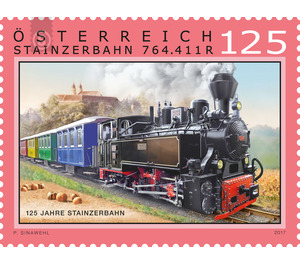125 years - Austria / II. Republic of Austria 2017 - 125 Euro Cent
Theme: Traffic, Transportation & Mobility
| Country | Austria / II. Republic of Austria |
| Issue Date | 2017 |
| Face Value | 125.00 |
| Edition Issued | 200,000 |
| Printing Type | Combination printing, offset stitch (Etch-Art by OeSD) |
| Stamp Type | Commemorative |
| Item Type | Stamp |
| Chronological Issue Number | 2683 |
| Chronological Chapter | OOS-OE2 |
| SID | 124884 |
| Dimensions | 32.00 x 42.00 |
| In 80 Wishlists | |
With a gauge of 760 millimeters, the "Bosnian Spur", the Stainzerbahn belongs to the narrow-gauge local railways in Austria. Since 1892 she drives the approximately 11.3-kilometer route between Preding and Stainz in western Styria. The special stamp shows the "Flascherlzug", in the background the picturesque castle Stainz. On November 26, 1892, the Stainzerbahn was opened with a route from the station Preding-Wieselsdorf, where there is a connection to the Wieserbahn the Graz-Köflacher Bahn, to Stainz. Until 1922, the route was operated by the Southern Railway Company, then by the Styrian Provincial Railways. Passenger traffic was finally discontinued in 1951, and in 1980, when the concession expired, regular freight traffic was also over. The locomotives and wagons were taken over by other routes of the Steiermärkische Landesbahnen. However, railway enthusiasts had already in 1971 launched a nostalgic steam train, which was so successful that it eventually became a permanent facility. The so-called Stainzer Flascherlzug is now operated as a tourist train by the municipality of Stainz. Also the building of the station Stainz and many rails originate from the founding time of the Stainzerbahn. The name Flascherlzug dates back to around 1920, when a miracle healer named Johann Reinbacher, also called "Höllerhansl", practiced in Rachling near Stainz. His patients usually traveled on the Stainzerbahn - an arduous journey, as his house was still a good eight kilometers from the station. In the luggage they had a vial of urine, because allegedly the Höllerhansl could diagnose the suffering of his patients and then treat them accordingly with herbal teas. The Stainzer Flascherlzug today a steam locomotive and reserve a diesel locomotive are used. The striking colorful passenger cars reflect the history of the railway: the green wagon is called Höllerhansl, the red Bergliesl (after a herb collector working for Höllerhansl) and the yellow herb wagon. Less historical than culinary is the name of the blue buffetwagens, which is vividly called "Schilcher swing". If necessary, other cars are used.


